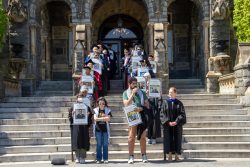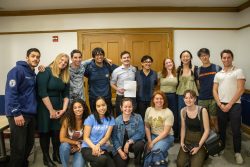So far, some of the most publicized stories of the nationwide Occupy movement have been about the protesters’ confrontations with law enforcement. The initial Wall Street protests produced the largest mass arrests since anti-Vietnam protests in the ‘70s, complete with images of seething, screaming activists confronting armored NYPD forces.
Oakland took the confrontations to a new level. Tear gas and rubber bullets unleashed on protesters during a peaceful march made the streets of the California town look more like Tahir Square a year ago. A 24-year-old Iraq War veteran suffered a fractured skull after being hit in the face by a police projectile. Arrests and tension have since mounted across the nation. Everywhere we look, the story seems to be Occupiers versus the law.
Until recently, this wasn’t the case in the District. Before last Friday, there had been no arrests of any McPherson Square activists. But last weekend, 500 occupiers turned out to protest a dinner meeting of Americans for Prosperity, a conservative group affiliated with the Tea Party. When the event ended, the protesters decided to occupy the intersections surrounding the building, preventing the dinner attendees from leaving. Four protesters were hit by a car. Accounts of the event differ widely between the police and occupiers, but two things are for sure: three protesters were arrested for failure to obey an officer, and the driver who hit the activists is not being charged by police.
This marked a high point of tension between the police and the protesters in McPherson, but on Sunday things were more or less back to normal during the Keystone XL Pipeline protest at the White House. The police stopped traffic on the designated protest route and expanded their protection to the streets around McPherson when the activists decided to continue the march there.
This sort of relationship is almost unthinkable in most other cities, and it reveals important elements of this particular Occupy’s professionalism and organization. On my trips down to the Square, I’ve repeatedly heard the D.C. operation praised for how calm it is. One line that’s often repeated is that D.C. is a “camp” while places like New York are “carnivals.”
The police contribute to the good vibes as well. They have made clear their intentions not to evacuate McPherson as long as the occupiers stay orderly and keep the place clean, which they are doing.
“In D.C. [the police] have a lot more experience dealing with protestors and also there’s a lot of litigation surrounding police brutality and things like that regarding protestors,” Drew Peterson, one of the McPherson occupiers said. Mayor Vincent Gray may also feel a special connection to the protesters, since he was arrested himself for blocking traffic back in April during a Voting Rights demonstration.
Even so, the police have announced changes to their strategy with the protests after Friday’s incidents. Police Chief Cathy Lanier said to the Washington Post that the protesters were “increasingly confrontational and violent,” and that “we do not condone, nor will we tolerate, violence or aggression.” The details of how the protestors have gotten more violent is lost on them, but it is clear in any case that the police are trying to inject a bit more order into the situation.
Behind the seemingly good-natured relationships between the police and the occupiers is a fair amount of antipathy on both sides. As the movement continues to expand, the stress of cold weather sets in, and protests become more earnest approaching the elections, tensions are only likely to rise around McPherson.
It’s up to both sides to keep the situation calm. Yes, from the protesters’ perspective, many of D.C.’s finest do have what Kerouac so deridingly labeled “cop’s souls”. But, while showing any amount of disrespect for them can feel validating, it will only undermine the movement in the eyes of politicians and the public. If the protesters are serious about achieving any of their diverse swath of policy objectives, they will understand the need to preserve positive relations with the police.
The same goes for the police. While the activists may be pests to many in law enforcement, they are adamant and committed to their cause. The winter will not likely break this movement like many police hoped. Their numbers continue to rise even as the cold presses closer.
If the police are planning to clear out McPherson any time soon, it will certainly mean violence and scandal. That’s in no one’s interest. The occupiers are likely to push the limits of police orders in the months to come. As dissidents, it is what they do. The Mayor and police force need to recognize that the true aims of this movement are completely non-violent, and that responding with an iron fist will only cause embarrassment and an escalation in problems. They need only look as far as Oakland to see it.
The protesters and police should regard their relationship as symbiotic and not confrontational. If they each let cooler heads prevail, the movement can enjoy increased popularity and legitimacy, the police can be lauded as reasonable and smart in dealing with the protests, and Mayor Gray can stay true to his activist roots. After all, the D.C. police are part of the 99 percent. If they respect the movement, their interests can be met just as much as those of the occupiers.
Let Gavin know if you would like to form a symbiotic relationship with him at gbade@georgetownvoice.com




